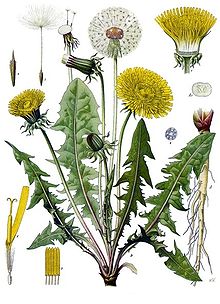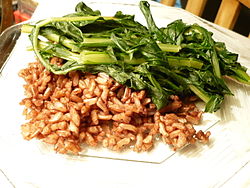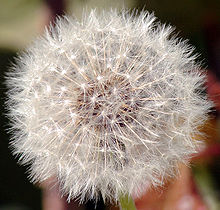- Taraxacum officinale
-
Taraxacum officinale 
Common Dandelion Scientific classification Kingdom: Plantae (unranked): Angiosperms (unranked): Eudicots (unranked): Asterids Order: Asterales Family: Asteraceae Tribe: Cichorieae Genus: Taraxacum Species: T. officinale Binomial name Taraxacum officinale
F.H. WiggSynonyms - Leontodon taraxacum L.
- Taraxacum dens-leonis Desf.
- Taraxacum retroflexum Lindl.
Taraxacum officinale, the common dandelion (often simply called "dandelion"), is a herbaceous perennial plant of the family Asteraceae (Compositae). It can be found growing in temperate regions of the world, in lawns, on roadsides, on disturbed banks and shores of water ways, and other areas with moist soils. T. officinale is considered a weedy species, especially in lawns and along roadsides, but it is sometimes used as a medical herb and in food preparation. As a nearly cosmopolitan weed, common dandelion is best known for its yellow flower heads that turn into round balls of silver tufted fruits that blow away on the wind.
Contents
Description
Taraxacum officinale grows from generally unbranched taproots and produces one to more than ten stems that are typically 5 to 40 cm tall but sometimes up to 70 cm tall. The stems can be tinted purplish, they are upright or lax, and produce flower heads that are held as tall or taller than the foliage. The foliage is upright growing or horizontally orientated, with leaves having narrowly winged petioles or being unwinged. The stems can be glabrous or are sparsely covered with short hairs. The 5–45 cm long and 1–10 cm wide leaves are oblanceolate, oblong, or obovate in shape with the bases gradually narrowing to the petiole. The leaf margins are typically shallowly lobed to deeply lobed and often lacerate or toothed with sharp or dull teeth. The calyculi (the cup like bracts that hold the florets) is composed of 12 to 18 segments: each segment is reflexed and sometimes glaucous. The lanceolate shaped bractlets are in 2 series with the apices acuminate in shape. The 14 to 25 mm wide involucres are green to dark green or brownish green with the tips dark gray or purplish. The florets number 40 to over 100 per head, having corollas that are yellow or orange-yellow in color. The fruits, which are called cypselae, range in color from olive-green or olive-brown to straw-colored to grayish, they are oblanceoloid in shape and 2 to 3 mm long with slender beaks. The fruits have 4 to 12 ribs that have sharp edges. The silky pappi, which form the parachutes, are white to silver-white in color and around 6 mm wide. Plants typically have 24 or 40 pairs of chromosomes but some plants have 16 or 32 chromosomes.[1] Plants have milky sap and the leaves are all basal, each flowering stem lacks bracts and has one single flower head. The yellow flower heads lack receptacle bracts and all the flowers, which are called florets, are ligulate and bisexual. The fruits are mostly produced by apomixis.[2] It blooms from March until October,[3]
Taxonomy
The taxonomy of the genus Taraxacum is complicated by apomictic and polyploid lineages,[4][5] and the taxonomy and nomenclatural situation of Taraxacum officinale is not yet fully resolved,[1] The taxonomy of this species has in the past been complicated by the recognition of numerous species,[6] subspecies and microspecies. E.g. Rothmaler's flora of Germany recognizes roughly 70 microspecies.[7] The plants introduced to North America are triploids that reproduce by obligate gametophytic apomixis[1][8] Some authorities recognize three subspecies of Taraxacum officinale including:[9][10]
- Taraxacum officinale ssp. ceratophorum (Ledeb.) Schinz ex Thellung which is commonly called common dandelion, fleshy dandelion, horned dandelion or rough dandelion. It is native to Canada and the western US.[11] Some sources list it as a species, Taraxacum ceratophorum.[12][13]
- Taraxacum officinale ssp. officinale, which is commonly called common dandelion or wandering dandelion.
- Taraxacum officinale ssp. vulgare (Lam.) Schinz & R. Keller, which is commonly called common dandelion.
Two of them have been introduced and established in Alaska and the third (ssp. ceratophorum ) is native there.[14]
Taraxacum officinale has historically had many English common names including: blowball, lion's-tooth, cankerwort, milk-witch, yellow-gowan, Irish daisy, monks-head, priest's-crown and puff-ball;[15] other common names include, faceclock, pee-a-bed, wet-a-bed, canker-wort,[16] and swine's snout.[17]
Carl Linnaeus named the species Leontodon Taraxacum in 1753. The genus name Taraxacum, might be from the Arabic word "Tharakhchakon",[2] or from the Greek word "Tarraxos". [18] The common name "dandelion," comes from the French phrase "dent de lion" which means "lion's tooth", in reference to the jagged shaped foliage.[18]
Weeds
Taraxacum officinale is a common colonizer after fires, both from wind blown seeds and seed germination from the seed bank.[19] The seeds remain viable in the seed bank for many years, with one study showing germination after nine years.[20] This species is a somewhat prolific seed producer, with 54 to 172 seeds produced per head, and a single plant can produce more than 5,000 seeds a year.[20] It is estimated that more than 97,000,000 seeds/hectare could be produced yearly by a dense stand of dandelions. When released, the seeds can be spread by the wind up to several hundred meters from their source, the seeds are also a common contaminate in crop and forage seeds. The plants are adaptable to most soils and the seeds are not dependent on cold temperatures before they will germinate but they need to be within the top 2.5 centimeters of soil.[14]
Dandelion (Taraxacum officinale) has also been linked to outbreaks of stringhalt in horses.[21][22]
While not in bloom, this species is sometimes confused with others, such as: Chondrilla juncea,[23] that have similar basal rosettes of foliage.
Distribution
Common dandelion is native to Eurasia,[24] and now is naturalized throughout North America, southern Africa, South America, New Zealand, Australia, and India. It occurs in all 50 states of the USA and most Canadian provinces.[14]
Uses
 A plate of sauteed dandelion greens, with Wehani rice
A plate of sauteed dandelion greens, with Wehani rice
While the dandelion is considered a weed by most gardeners and lawn owners, the plant has several culinary uses. The specific name officinalis refers to its value as a medicinal herb, and is derived from the word opificina, later officina, meaning a workshop or pharmacy.[25] The flowers are used to make dandelion wine,[26] the greens are used in salads, the roots have been used to make a coffee-like drink and the plant was used by Native Americans as a food and medicine. [27]
Dandelions are grown commercially on a small scale as a leaf vegetable. The leaves (called dandelion greens) can be eaten cooked or raw in various forms, such as in soup or salad. They are probably closest in character to mustard greens. Usually the young leaves and unopened buds are eaten raw in salads, while older leaves are cooked. Raw leaves have a slightly bitter taste. Dandelion salad is often accompanied with hard boiled eggs. The leaves are high in vitamin A, vitamin C and iron, carrying more iron and calcium than spinach.[28]
Dandelion flowers can be used to make dandelion wine, for which there are many recipes.[29] It has also been used in a saison ale called Pissenlit (literally "wet the bed" in French) made by Brasserie Fantôme in Belgium. Another recipe using the plant is dandelion flower jam. Ground roasted dandelion root can be used as a coffee substitute. In Silesia and also other parts of Poland and world, dandelion flowers are used to make a honey substitute syrup with added lemon (so-called May-honey). This "honey" is believed to have a medicinal value, in particular against liver problems.[30]
Dandelion root is a registered drug in Canada, sold principally as a diuretic. A leaf decoction can be drunk to "purify the blood", for the treatment of anemia, jaundice, and also for nervousness. A hepatoprotective effect of chemicals extracted from dandelion root has been reported.[31] Drunk before meals, dandelion root coffee is claimed to stimulate digestive functions and function as a liver tonic. "Dandelion and Burdock" is a soft drink that has long been popular in the United Kingdom with authentic recipes sold by health food shops. It is unclear whether cheaper supermarket versions actually contain extracts of either plant.
The milky latex has been used as a mosquito repellent;[32] the milk has also been used to treat warts, as a folk remedy.[33]
Yellow or green dye colours can be obtained from the flowers but little colour can be obtained from the roots of the plant.[34]
T. officinale is food for the caterpillars of several Lepidoptera (butterflies and moths), such as the tortrix moth Celypha rufana. See also List of Lepidoptera that feed on dandelions.
References
- ^ a b c "Taraxacum officinale in Flora of North America @". Efloras.org. http://www.efloras.org/florataxon.aspx?flora_id=1&taxon_id=220013281. Retrieved 2011-10-23.
- ^ a b Morley, T. I. (1969). "Spring Flora of Minnesota". 1974 reprint with minor corrections (University of Minnesota Press, Minneapolis MN): 255
- ^ Rose, Francis (1981). The Wild Flower Key. Frederick Warne & Co. pp. 388,391. ISBN 0-7232-2419-6.
- ^ Wittzell, Hakan (1999). "Chloroplast DNA variation and reticulate evolution in sexual and apomictic sections of dandelions". Molecular Ecology 8 (12): 2023. doi:10.1046/j.1365-294x.1999.00807.x. PMID 10632854
- ^ Dijk, Peter J. van (2003). "Ecological and evolutionary opportunities of apomixis: insights from Taraxacum and Chondrilla". Philosophical Transactions of the Royal Society B Biological Sciences 358 (1434): 1113. doi:10.1098/rstb.2003.1302. PMC 1693208. PMID 12831477. http://www.pubmedcentral.nih.gov/articlerender.fcgi?tool=pmcentrez&artid=1693208
- ^ Thomas Gaskell Tutin (1976). Flora Europaea: Plantaginaceae to Compositae (and Rubiaceae). Cambridge University Press. pp. 332–. ISBN 9780521087179. http://books.google.com/books?id=QXRooltqAVMC&pg=PA332. Retrieved 29 October 2010.
- ^ Rothmaler, Werner (1966). Exkursionsflora: Kritischer Ergänzungsband Gefäßpflanzen. p. 347.
- ^ Lyman JC, Ellstrand NC (1984). "Clonal diversity in Taraxacum officinale (Compositae), an apomict". Heredity 53 (1): 1–10. doi:10.1038/hdy.1984.58. http://www.nature.com/hdy/journal/v53/n1/abs/hdy198458a.html.
- ^ "ITIS Standard Report Page: Taraxacum officinale". Itis.gov. 2010-05-13. http://www.itis.gov/servlet/SingleRpt/SingleRpt?search_topic=all&search_value=Taraxacum+officinale&search_kingdom=every&search_span=exactly_for&categories=All&source=html&search_credRating=All. Retrieved 2011-10-23.
- ^ Robert F. Barnes; C. Jerry Nelson; Kenneth J. Moore; Michael Collins (19 January 2007). Forages: The science of grassland agriculture. Wiley-Blackwell. pp. 11–. ISBN 9780813802329. http://books.google.com/books?id=AanCgHZ1mhwC&pg=PA11. Retrieved 29 October 2010.
- ^ "PLANTS Profile for Taraxacum officinale ssp. ceratophorum (common dandelion) | USDA PLANTS". Plants.usda.gov. http://plants.usda.gov/java/profile?symbol=TAOFC. Retrieved 2011-10-23.
- ^ "Taraxacum ceratophorum". Calflora. http://www.calflora.org/cgi-bin/species_query.cgi?where-calrecnum=8991. Retrieved 2011-10-23.
- ^ "Taraxacum ceratophorum in Flora of North America @". Efloras.org. http://www.efloras.org/florataxon.aspx?flora_id=1&taxon_id=242351280. Retrieved 2011-10-23.
- ^ a b c "What is AKEPIC? | Alaska Natural Heritage Program". Akweeds.uaa.alaska.edu. 2010-11-15. http://akweeds.uaa.alaska.edu/pdfs/species_bios_pdfs/Species_bios_TAOF.pdf. Retrieved 2011-10-23.
- ^ Britton, N. F.; Brown, Addison (1970). An illustrated flora of the northern United States and Canada: from Newfoundland to the parallel of the southern boundary of Virginia, and from the Atlantic Ocean westward to the 102d meridian. New York: Dover Publications. p. 315. ISBN 0-486-22644-1.
- ^ http://www.nps.gov/akso/NatRes/EPMT/Species_bios/Taraxacum%20officinale.pdf
- ^ Loewer, Peter (2001). Solving weed problems. Guilford, Conn.: Lyons Press. p. 210. ISBN 1585742740. http://books.google.com/?id=5M1GqKyIiEoC&pg=PA210&lpg=PA210&dq=Swine%27s+Snout
- ^ a b Kowalchik, Claire; Hylton, William H.; Carr, Anna (1987). Rodale's illustrated encyclopedia of herbs. Emmaus, Pa.: Rodale Press. p. 141. ISBN 0-87857-699-1.
- ^ "Taraxacum officinale". Fs.fed.us. http://www.fs.fed.us/database/feis/plants/forb/taroff/all.html. Retrieved 2011-10-23.
- ^ a b "View source - Wikipedia, the free encyclopedia". En.wikipedia.org. 2009-03-05. http://en.wikipedia.org/w/index.php?title=Taraxacum_officinale&action=edit§ion=3. Retrieved 2011-10-23.
- ^ Australian stringhalt Retrieved on 5 March 2009
- ^ [1][dead link]
- ^ "Washington State Noxious Weed Control Board". Nwcb.wa.gov. 2008-09-10. http://www.nwcb.wa.gov/weed_info/Chondrilla_juncea.html. Retrieved 2011-10-23.
- ^ Vít Bojňanský; Agáta Fargašová (2007). Atlas of Seeds and Fruits of Central and East-European Flora: The Carpathian Mountains Region. シュプリンガー・ジャパン株式会社. pp. 751–. ISBN 9781402053610. http://books.google.com/books?id=QSMe0qHGVaAC&pg=PA751. Retrieved 29 October 2010.
- ^ Stearn, W.T. 1992. Botanical Latin: History, grammar, syntax, terminology and vocabulary, Fourth edition. David and Charles.
- ^ "Recipes - Dandelion Wine". Cooks.com. http://www.cooks.com/rec/search/0,1-00,dandelion_wine,FF.html. Retrieved 2011-10-23.
- ^ Clarke, Charlotte Bringle (1977). Edible and useful plants of California. Berkeley: University of California Press. p. 191. ISBN 0-520-03261-6.
- ^ Common Dandelion
- ^ winemaking: Dandelion Wines
- ^ Wera Sztabowa, "Krupnioki i moczka, czyli gawędy o śląskiej kuchni", Wydawnictwo Śląsk, Katowice, 1990, ISBN 83-216-0935-X.
- ^ A. Mahesh, R. Jeyachandran, L. Cindrella, D. Thangadurai, V. P. Veerapur, D. Muralidhara Rao (2010). Hepatocurative potential of sesquiterpene lactones of Taraxacum officinale on carbon tetrachloride induced liver toxicity in mice. Acta Biologica Hungarica 61(2):175-190. abstract
- ^ Plantwatch - Plants
- ^ Dandelion - The Natural History Museum - Country Cures
- ^ A. Dyer (1976) Dyes from natural sources. G. Bell & Sons Ltd., London
- Blanchan, Neltje (2005). Wild Flowers Worth Knowing. Project Gutenberg Literary Archive Foundation. ISBN 0665989342.
- Everitt, J.H.; Lonard, R.L., Little, C.R. (2007). Weeds in South Texas and Northern Mexico. Lubbock: Texas Tech University Press. ISBN 0896726142. ISBN 0-89672-614-2
- Köhler, Franz Eugen (1887). Köhler's Medicinal Plants. Gustav Pabst.
External links
- Dandelion (Taraxacum officinale): Detailed information about edibility.
Categories:- Taraxacum
- Herbs
- Medicinal plants
- Flora of Michigan
- Flora naturalised in Australia
- Invasive plant species
- Ruderal species
- Least concern plants
- Plant dyes
- Leontodon taraxacum L.
Wikimedia Foundation. 2010.


